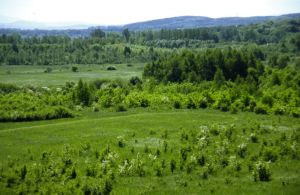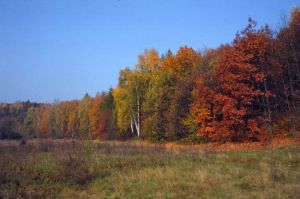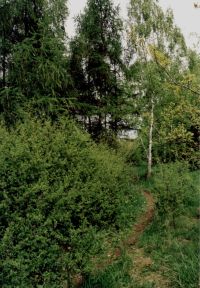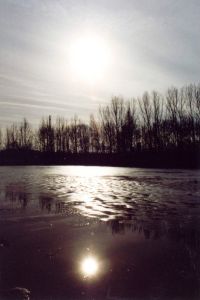|
1. The valuable elements of landscape and nature and the need to protect them
The area situated between the Skotniki, Kostrze and Pychowice localities is one of those places within Krakow, where the cultural landscape has survived with its full abundance of nature and historical heritage. It is a complex of picturesque meadows surrounded by forest-clad limestone hills which offers a place of recreation to many Krakow residents. Its nature and history have been chosen as a subject of numerous papers where the need to protect this area was always highlighted. On the one hand, as the area yields to intensifying pressure from human impact and to changes resulting from the abandonment of the earlier methods of land use (cutting for hay, grazing, etc.) in such sites in Krakow and elsewhere, on the other hand the number of the areas of this grade is greatly reduced. The most valuable resources of the environment often disappear, bringing the loss of cultural values, and hence, taking away the possibilities to use the area for recreational or scientific purposes.

|
|
Meadow complex at Kostrze;
phot. January Weiner
[+] |
The area concerned is situated in the south-western part of Krakow between the localities of Skotniki, Kostrze, Bodzów and Pychowice, in the fork of two streets: Tyniecka and Winnicka (Podgórze district), some 4 - 5 km from the city centre. The area encompasses a complex of meadows and woods, including Łąki Królówki (meadows) and a wood on Góra Pychowicka (hill). The whole complex covers 3.9 km2.
2. Land use plans for the area
In the land use and spatial plans, some of the area now occupied by meadows has been designated for the development of the Third Campus of the Jagiellonian University whereas the remaining land is proposed to become a public park (the Jagiellonian Park). Particularly noteworthy is the fact that most of the area concerned is already covered by the Bielańsko - Tyniecki Landscape Park, within the system of the Jurassic Landscape Parks complex.
3. Landscape in its physiognomic and cultural aspects
The landscape of Jura Krakowsko - Częstochowska (Jurrasic area), in which the site of the Third Campus of the Jagiellonian University is situated, is that of the Bielańsko - Tyniecki landscape park, an area of high diversity in terms of geological forms, nature and human activities. The relief, geological structure, and habitat conditions were among the factors which helped shaped the 'human economy' in the area. The isolated fault ridges (horsts) of the Brama Krakowska (rocky gate) and the small flattened hill tops and steep limestone slopes were not suitable for settlements or growing crops; therefore oak-hornbeam and beech woods developed there as well as thermophilous bushes, which have long since disappeared. The valleys, once occupied by riparian woods have now been taken over by meadows and pastures. The landscape of this portion of Krakow can be perceived as a cultural landscape recording the twists and turns of history, much degraded through infrastructure development and expansion of human settlements, not often matching the 'tradition of the site'.
The eastern border of the area under study is flanked by tall blocks of flats comprising the Ruczaj-Zaborze housing estate and by those institutes belonging to the third Campus of the Jagiellonian University, whose construction has now been completed. The vista to the north-east, is of a magnificent landscape with Solnik hill in the foreground, and further on, against a backdrop of the Las Wolski (wood), the Camaldese monks monastery at Bielany, as well as the Przegorzały locality. Towards the south-west, there is a view of the undulating area of the Podgórki Tynieckie hills, and - weather permitting - the panoramic view of the Beskidy mountains.
The area described offers a variety of characteristic fragments and vistas. The differences among particular fragments results from the differences in relief and vegetation cover (plant communities, geological substrate, bodies of water). The perception of these fragments depends on season and related aspects of plant communities occurring in the area.

|
|
Vicinity of Góra Pychowicka;
phot. January Weiner
[+] |
The picturesque landscape of the Królówki meadow complex can be viewed from Solnik hill. It is a truly panoramic view of meadows and reed fens, whose eastern border has a forest-clad hill (Góra Pychowicka). In the distance there are housing estates and the centre of Krakow (with Wawel hill among other features).
Embedded in the landscape of the Królówki meadows are the nearby remnants of the historical Krakow Fortress (dating back roughly to the period 1850-1910), the ruins of the Bodzów fort and caverns (underground chambers) on Solnik hill, the Winnica fort on Winnica hill, and the caverns hidden in the wood on Góra Pychowicka (hill).
4. An inventory and evaluation of both landscape and nature
4.1. Plant communities and their protection
In the meadows around the third Campus of the Jagiellonian University, a great variety of habitats occur. Small patches of the site are covered by little woods and groves planted on grounds once occupied by meadows. These are mainly alderwood communities with black alder Alnus glutinosa as a dominant species, and with a minor proportion of birch Betula pendula. Along roads, the edges of these groves are outlined by various blackberry Rubus species. There also a patch of oak artificial wood planted near the northernmost pond, where besides the common (pedunculate) oak Quercus robur, there is also common birch Betula pendula, Norway spruce Picea exclsa and black alder Alnus glutinosa. Among the meadows there are irregularly spaced cultivated fields and plantations of grey willow.
On the hill top of the Góra Pychowicka hill, there is a wood dissected by a belt of xerothermic grasslands with high proportions of trees and shrubs. The dominant species in the wood are: common birch Betula pendula, little-leaf linden Tilia cordata, common oak Quercus robur and hornbeam Carpinus betulus. European larch Larix decidua, sycomore maple Acer pseudoplatanus, Norway maple Acer platanoides, Scots pine Pinus sylvestris and several other species also occur. At the border between woods and meadows blackthorn Prunus spinosa shrub abounds, along with an ecotone community, with a major proportion of species involved with the association Koelerio - Festucetum sulcatae.

|
|
Forest on the hill Góra Pychowicka;
phot. Aleksandra Pępkowska
[+] |
Within the complex of meadows in Kostrze, the following meadow communities can be found:
- Molinietum coeruleae;
- Cirsio - Polygonetum;
- Caricetum gracilis;
- Caricetum davallianae;
- Arrhenatheretum elatioris;
- Koelerio - Festucetum sulcatae;
- Cirsietum rivularis;
- Filipendulo - Geranietum.
There are also patches of meadows under various stages of succession (dominated by high perennial plants but less rich in species compared with the composition of typical associations), ruderal communities, and areas under cultivation.
The plant associations identified there include: Molinietum coeruleae, Cirsietum rivularis, Angelico - Cirsietum oleracei, Arrhenatheretum elatioris, Caricetum davallianae, Caricetum gracilis, and Koelerio - Festucetum sulcatae all subject to legal protection in Poland. These communities represent the habitats of plant species threatened throughout Europe (listed below) and of animal species. Thus, they were included in the Habitats Directive's list of so-called habitats of European significance (Council Directive 92/43/EEC of 21 May 1992 on the Conservation of Natural Habitats and Wild Flora and Fauna. Official Journal of the European Communities, Brussels). The patches of Molinietum coeruleae, which develop within Łąki Królówki (meadows) are classified as an association rare in the Krakow area (other stations being at: Sidzina, Kobierzyn, and close to the Kliny housing estate) and listed as the most valuable. Another particularly valuable association is also short sedge mire Caricetum davallianae, a community which occurs very rarely within the city's limits.
4.2. Rare and protected species of vascular plants
Rare and protected species of vascular plants occurring in the meadow complex called Łąki Królówki are listed below. The categories applied follow the Distribution atlas of vascular plants in the Kraków voivodship (Zając i Zając, 1998): E - endangered species (species nearing extinction, whose survival is not very likely if the threatening factors continue); V - vulnerable (species which will soon be reclassifiedin the category of endangered species if the threatening factors continue); R - rare (species of limited distribution ranges, small areas of habitats, or occurring over a large area but scattered widely over it); * - species which are subject to legal protection in Poland.
meadow community Molinietum coeruleae:
Dianthus superbus* (see phot.) - E
Gentiana pneumonathe* (see phot.) - V
Gladiolus imbricatus* (see phot.) - V
Gymnadonia conopsea* - E
Iris sibirica* (see phot.) - E
Thalictrum lucidum - V
Trollius europaeus* (see phot.) - V
meadow community Molinietalia:
Cirsium canum - R
Lathyrus palustris* - E
Orchis incarnata* - E
O. latifolia*
Ornithogalum umbellatum - V
Primula elatior*
Veronica longifolia - V
meadow community Caricetum davalianae:
Carex davalliana - E
Epipactis palustris* (see phot.) - E
Orchis maculata*
Platanthera bifolia* (see phot.)
meadow community Festuco - Brometea:
Anthericum ramosum - R
Carlina acaulis*
Primula officinalis*
Prunella grandiflora - R
Pulsatilla pratensis* (see phot.)
Thymus glabrescens - R
4.3. Butterflies
Among butterflies occurring at the Kostrze meadow complex, several species closely associated with certain meadow communities are particularly worthy of note: swallowtail Papilio machaon, scarce large blue Maculinea teleius (see phot.), dusky large blue M. nausithous, alcon blue M. alcon, and violet copper Lycaena helle (see phot.).
Maculinea teleius and M. nausithous are among the rarest butterflies worldwide and they have been placed on the lists of species of so-called Community interest in the Habitats Directive. The same directive also lists violet copper. In Poland all these species are covered by legal protection. The same protection applies to swallowtail Papilio machaon (Rozp. MŚ z dn. 26 września 2001 r.). (Regulation of the Minister for Environment of 26 September 2001). All the 'blues' listed for the area concerned as well as violet copper are listed as vulnerable (The Red book of endangered and vulnerable animals in Poland).
The main threat to these species is the disappearance of the habitats which serve as their refuges. The completion of the development in Maculinea sp. and Lycaena helle depends upon, among other factors, the presence of suitable fodder plants in meadow communities. In the cases of Maculinea teleius and M. nausitous, this fodder plant is great burnet (see phot.), for M. alcon - marsh gentian (see phot.) and for Lycaena helle European bistort. Additionally, to complete their development, these butterflies require the presence of certain species of ants, namely myrmicine ants (harvester ants) of the genus Myrmica.
4.4. Amphibian and reptile fauna
Within the area of the newly constructed campus of the Jagiellonian University, there are three refuges of amphibians: two larger bodies of water and a group of three small ponds with a nearby seasonally inundated depression (in autumn, early spring), or during torrential rains. In the period from April to June 2001, seven species of amphibians were observed there: European toad Bufo bufo (see phot.), common tree frog Hyla arborea, European frog Rana esculenta, moor frog R. arvalis, marsh frog R. ridibunda, crested newt Triturus cristatus, and common newt T. vulgaris. Six of these species had been observed in Kraków earlier whereas the marsh frog has been recorded for the first time. The sites differ both in species composition and numbers of amphibians.

|
|
Amphibian habitat at Kostrze;
phot. Aleksandra Pępkowska
[+] |
Both the viviparous lizard Lacerta vivipara, and sand lizard Lacerta agilis occur commonly in the area. A water snake Natrix natrix has also been observed there.
All amphibian and reptile species observed in the Królówki meadows are covered by legal protection in Poland. Particularly valuable are those species which are also rarest throughout the city; namely the crested newt and moor frog. The reptile fauna in Krakow is extremely poor - a mere three species are found. It should also be noted that crested newt, moor frog, marsh frog and sand lizard are so-called species of Community interest, being particularly vulnerable throughout Europe.
4.5. Bird fauna
In the area of the third Campus of the Jagiellonian University, a total number of 55 bird species were observed. The species common throughout the area included: willow warbler, marsh warbler, whinchat, pheasant, and whitethroat. Rarely observed were: garden warbler Sylvia borin, goldcrest Regulus regulus, house sparrow Passer domesticus, tree sparrow Passer montanus, kestrel Falco tinnunculus, meadow pipit Anthus pratensis, nightingale Luscina megarhynchos, wheatear Oenathe oenathe, and hawfinch Coccothraustes coccothraustes. For the majority of the species (whose complete list is given below) the Królówka meadow complex and adjacent areas provide breeding sites, whereas swift, white stork, swallow, and rook - only forage there
The bird species occurring in the areas adjacent to the third Campus of the Jagiellonian University are covered by legal protection. The only exceptions are game species, covered by hunting laws: pheasant, partridge, mallard, and wood pigeon. Three out of the entire number of bird species are listed as endangered throughout the European continent (Bird Directive): corn cracke, red-backed shrike, and white stork. In the Małopolska region, these species occur in fairly low numbers (Walasz and Mielczarek, 1992).
List of bird species from area of Kostrze:
Corvus frugilegus
C. Moledula
Pica pica
Garrulus glandarius
Oriolus oriolus
Sturnus vulgaris
Coccothraustes coccothraustes
Serinus serinus
Acanthis cannabina
Carduelis carduelis
Emberiza citrinella
E. Schoeniclus
Passer montanus
P. domesticus
Alauda arvensis
Anthus trivialis
A. Pratensis
Sylvia borin
S. Atricapilla
S. Communis
S. Curruca
Phylloscopus collybita
P. trochilus
P. sibilatrix
Acrocephalus palustris
Locustella naevia
L. Fluviatilis
Regulus regulus
Remiz penduinus
Parus major
P. caeruleus
Trudus merula
T. Pilaris
T. philomelos
Oenathe oenathe
Saxicola ruberta
Saxicola torquata
Luscina megarhynchos
Erithacus rubecula
Lanius collurio
Hirundo rustica
Apus apus
Cuculus canorus
Buteo buteo
Falco tinnunculus
Accipiter gentilis
A. Nisus
Columba palumbus
Phasianus colchicus
Pedrix pedrix
Coturnix coturnix
Crex crex
Vanellus vanellus
Anus platyrhynchos
Gallinago gallinago
Ciconia ciconia
4.6. Bats
The caverns and forts of the 19th-century Fortress Krakow offer habitat/microclimatic conditions similar to natural caves and for this reason they are the principal places where bats can hibernate within the area of the city. During the studies carried out from 1954 - 1992, on the species of bats wintering in these facilities, 10 bat species were recorded, out of which 6 occurred in the caverns of Pychowicka Hill. These were: lesser horsehoe bat Rhinolopus hipposideros, brown bat Myotis myotis, Natterer's bat M. nattereri, common long-eared bat Plecotus auritus, grey long-eared bat Plecotus austriacus, and common barbastelle Barbastella barbastellus. In the nearby caverns of Solnik Hill, one more species (Geoffrey's bat Myotis emarginatus) was also noted; bats are also known to hibernate in the Winnica fort.
All the species of bats found in the area are subject to legal protection in Poland. Among them, particularly endangered in Poland are: the lesser horsehoe bat and Geoffrey's bat. All these bat species are listed as being of particular importance to the whole of Europe.
4.7. Game animals
The area of the third Campus of the Jagiellonian University is situated within the 31st Hunting District (Podwawelskie hunters' club). The inventory of game species covered only mammals. In the 2001/02 hunting season (April 2001 - March 2002) the following species were observed: hare Lepus europaeus (low number), fox Vulpes vulpes (very numerous), roe deer Capredus capredus (some 15 individuals), and wild boar Sus scrofa (7 - 8 individuals)
Written by Aleksandra Pępkowska
on the basis of a master's thesis (Pępkowska, 2002)
|

